
support to improve Lombard Street.
(Photo © J. Maus/BikePortland)
The fact that 100 people showed up to last night’s Lombard Re-Imagined open house, is a clear sign that a group of Portland State University graduate students has spurred an important conversation about the future of Lombard Street. Put together by Swift Planning Group, the open house came after months of meetings, walking tours, design analysis, a neighborhood survey and more.
With a final report due next month, Swift and their neighborhood partners are zeroing in on specific recommendations they hope to get implemented by the City of Portland, the Oregon Department of Transportation, and other local agencies.
Lombard is a classic, auto-centric urban arterial. It’s a state highway, but it also happens to run through dense residential and commercial areas where people live, shop and work. With its high speed traffic and lack of humane design features, the street lacks the social and commercial vibrancy and sense of place that neighborhood residents are clamoring for. Put another way, Project Manager Kathryn Doherty-Chapman wrote via email to me after the open house, “People want places to meet their neighbors, to be able to walk their kids to school and to nearby parks, and to support locally owned businesses. Currently those activities are limited on Lombard, but they don’t have to be.”
Given what I’ve learned from a variety of sources, there appears to be a real chance that Lombard Street — at least between N. Chautauqua and NE Martin Luther King Jr. Blvd — could get a road diet. That is, the street’s current 51-feet wide, four-lane cross-section (with a parking lane on one side) could be altered to just three lanes (one in each direction and a center turn lane) and some combination of auto parking and/or bike lanes.
Here are the three configuration concepts that were shown last night:
Concept 1) Keep the current configuration and improve the parking lane…
Concept 2) Go to three lanes and have a parking lane on both sides…
Concept 3) Go to three lanes and put bike lanes on each side…
It’s important to note that a recent traffic analysis performed by the planning group’s tech research specialist, Jake Warr, showed that reducing one lane of motor vehicle travel on Lombard Street will still allow the street to beat acceptable congestion targets. In other words, PBOT could do this road diet without causing congestion — a key regulatory hurdle any street under consideration for a motor vehicle lane reduction must get over.
“We would love to see bike lanes on Lombard but only if it happens in a way that accommodates existing levels of freight access on that street.”
— Gerik Kransky, BTA Advocacy Director
Another thing to keep in mind is that Lombard is extremely unsafe in its current condition. According to ODOT’s 2009-2011 Safety Priority Index System (SPIS), this stretch of Lombard includes a segment (from N Fenwick to Interstate) that is in the top 5 percent most dangerous roadways in the state as well as several segments in the top 10 percent. I mention that because studies show a clear connection between road diets and improved safety.
At the open house, the public was asked to vote on their preferred concepts. According to Hamilton, concepts two and three received an equal number of votes. Asked about the overall tone of public comment at the open house, Hamilton said, “Lots of people said that changing to 3 lanes and/or other traffic calming methods are the most important changes that could happen.”
As for the bike lane question — it has spurred quite a bit of discussion among planners and the public.
Lombard is a state highway and designated freight route and removing the parking lane isn’t on the table (it’s between seven and nine feet wide in the concepts). With a motor vehicle lane width of 11-feet, that leaves only five feet for the bike lanes — which is a foot narrower than what’s commonly used and recommended in Portland.
“This street has to work. We have to be a city of short trips and this is a very important street if we’re going to make that happen.”
— Roger Geller, PBOT Bicycle Coordinator
Since this is a major freight corridor, the ODOT looms large in the discussions. Tony Coleman, ODOT’s Freight Mobility and Construction Project Liaison, was at the open house. I asked him about the bike lane idea and he seemed open to it; but only if the adjacent motor vehicle lane could be widened to 12 feet. “If they can figure out a 12-foot lane adjacent to the bike lane, we could work with that.”
Coleman said an 11-foot lane directly adjacent to a bike lane is simply too close for comfort for large truck operators. He also told me a story about a company that recently moved a massive ferry hull down Lombard. It was 120 feet long, 16-feet high, and 20.5-feet wide.
Bicycle Transportation Alliance Advocacy Director Gerik Kransky has made collaboration between bike and freight advocates a top priority. He says the BTA would, “love to see bike lanes on Lombard,” but he adds, “only if it happens in a way that accommodates existing levels of freight access on that street.”
Here’s more from Kransky:
“We are committed to finding ways to make big streets safe. On Lombard we may have an opportunity to balance the neighborhood character of the street with the existing freight route designation. In option [concept] three, it seems like a good compromise to have freight’s preferred lane width while providing a safe place for people who ride bikes.”
“We certainly see both sides of this story,” says Rebecca Hamilton of Swift Planning Group, “a direct E-W bike route is needed, but it is hard to imagine the high-traffic Lombard we know today carrying bike traffic with 5-foot lanes. A lot of cyclists said that improved parallel routes were fine and were preferable to a narrow bike lane on a busy street.”
(For what it’s worth, as someone who lives a few blocks from Lombard, I’m not aware of any high-quality parallel routes that can match Lombard for efficient east-west access to major destinations.)
Portland Bureau of Transportation Bicycle Coordinator Roger Geller was also at the open house (he and other PBOT staffers have requested a meeting with Swift Planning Group next week). The Bike Plan for 2030, which Geller helped write, includes Lombard as a designated “city bikeway.” “Given its location and zoning [it’s got a strong commercial zoning designation], this street has to work,” he told me, “We have to be a city of short trips and this is a very important street if we’re going to make that happen.”
Another issue at play in any discussion of bicycling and street re-design in north Portland is how it might impact the character of the neighborhood. Swift’s Doherty-Chapman said they’ve heard from many people who, “don’t want to see Lombard gentrify.” “They don’t want it to turn into a N. Williams. People love their neighborhoods and want to retain the diversity that currently exists, they just want to be able to walk around safely and comfortably, and have places to walk to.”
—
It’s important to note that this project is about much more than lane configurations. The vision for Lombard that Swift plans to create by next month includes ideas for how to develop more vibrant commercial centers, add new streetscape elements, improve dangerous crossings, and so on. Get involved and let them know your thoughts on the Lombard Re-Imagined website and Facebook page.



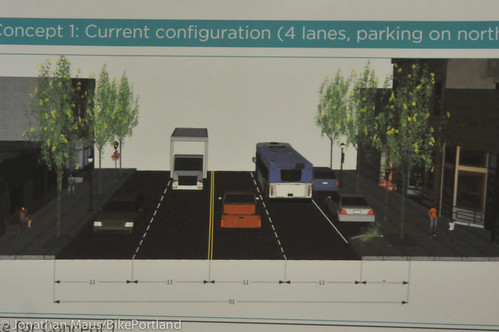
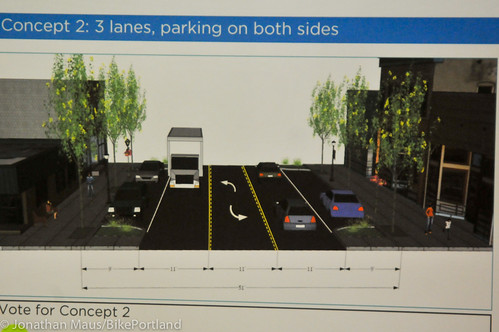
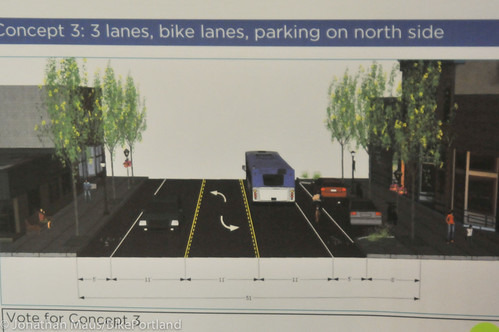

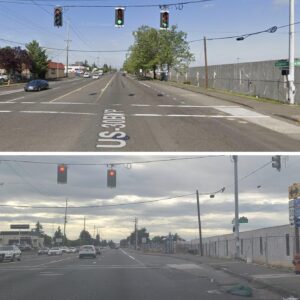
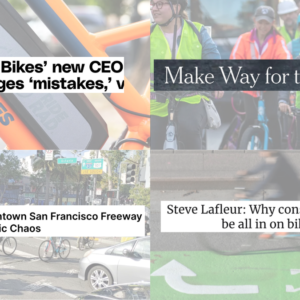
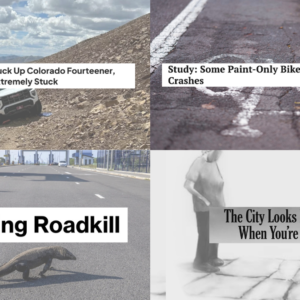
Thanks for reading.
BikePortland has served this community with independent community journalism since 2005. We rely on subscriptions from readers like you to survive. Your financial support is vital in keeping this valuable resource alive and well.
Please subscribe today to strengthen and expand our work.
One element of traffic calming that seems to always be disregarded is chicanes. In the Kenton streetscape redesign process, it was an option (with angled parking I believe), but it wasn’t chosen. In this instance you could do the asymmetric “concept 3” and have the parking on one side of the street for one block, then on the other side on the next block, and alternate back and forth. This would reduce the “landing strip” feel of the street and hopefully calm the tendency to want to blast down the straight line as fast as possible. Is the complexity more expensive to implement? Are people simply unfamiliar and nervous about trying this method? I don’t understand why it’s so rare.
The transitions back and forth take up a lot of space and trucks need wider lanes for tracking around any curve.
Even with bike lanes on Lombard I don’t prefer to ride next to big trucks going 35-40 mph. I vastly prefer Willamette to get into St. John’s & NoPo and don’t see that changing, bike lanes or not. As a cyclist I prefer option #2.
Agreed, especially with just a 5′ lane. Option 2 will hopefully improve safety and help businesses with street parking. I’d love to see better greenways running parallel to Lombard and some bike parking on side streets. Lombard can still be accessible to bikes without lanes.
If ODOT can work out a solution with protected bike lanes, I’d be all for it. As option 3 stands, it looks too dangerous.
The greenways parallel to Lombard are inherently compromised by the irregular layout of the neighborhoods. It’s basically impossible, without tearing down lots of houses and building new streets, to have a simple straight shot from I-5 to St. Johns like Lombard has. Instead, you have to navigate a complicated network of side streets. Sharrows and wayfinding signs are helping, but it’s still complicated and will take time for people to understand the new greenway network, whereas driving down Lombard is incredibly simple and intuitive.
I’m curious if they measured how wide Lombard is or scaled off of GIS and aerial photos. I’m not sure they have more than 50 feet to work with, and narrowing sidwalks is a non-starter.
I also live three blocks off of Lombard and find Rosa Parks, Ainsworth and Willamette to all be nice east/west options. Or, just weaving through the neighborhoods, which is incredibly easy. It seems like extreme shoehorning to put a bike lane on the only non-height restricted freight route in North Portland.
Ditto, though I suppose my feelings might change if there were on that part of Lombard.
Baloney….I also live one block N.of Lombard.
98% of all truck traffic with three or more axles are through traffic.
Truck traffic on Lombard needs to be reduced to local delivery only.
Tthe overheight issues on Columbia need to be addressed and changed.
In the feasability study below provided by JonLui’s link it seems the only set back to this fixing an outdated rail overpass
.
If everyone choses to himhaw over this the face of Lombard with a lackluster attitude, it will forever remain as it is.
IMO, this could be accomplished.
Speaking to peoples comfort levels riding in bike lane next to large trucks, I also say….baloney.
You are at a far greater constant risk with auto traffic .
Something needs to be done to make Lombard SOMEWHAT more livable.
This is a bigger chance for change, and you need to buck up and get real.
I also “weavethroughthehood” everyday. It can be done. But the issue here is to condition traffic AND include a safer avenue for peds/cyclists.
I have been in Portland 12 years, and ride Lombard as it is, next to trucks, all the way to the bridge, and then continuing out the HWY to Sauvies.
It is done daily by some, and it CAN be FAR better if people work to inform and expand pressure on the issue.
NO WIMPY WHINNNNNNING, lets do this!!!!!
In addition, on a related non-sequitar, N. Portland is laced with some of the highest levels of benzine as a result of the i-5 corridor, the airport and commercial freight.
This is also something residents can improve by pressuring lawmakers to move on having it removed from fuels as an anti-knck additive.
That is its prime beneifit to gasoline,…anti knock.
Look up the benzine levels for NOPO yourself. and I believe you will be amazed.
The designation is ‘overdimensional’ and refers not simply to height, but also width, length and weight. Several of the bridges on Columbia are unable to support over-weight vehicles.
I’m glad you like riding next to trucks. Bully for you. We all don’t want the same things.
And a lot of the people North Portland drive those trucks for a living.
My father was a Teamster for 48 years. I loves me some truck drivers o.k.?
What does that OR the matter of people in NoPo driving trucks for a living have to do with conceptualizing much needed change on the way truck traffic affects livability in this area?
That is the question.
And dont hit me with gentification either. lots of poor folks, (myself included) are not gonna be run out of here anytime soon.
I say the working class and working poor along this roadway deserve a better quality of life… along Lombard.
That includes usable bike infrastructure from MLK to St. Johns.
Sorry, I am sick of truck traffic in my front yard. I am not an entitled yuppie buying up houses to flip either.
Fix or build new bridges, along Columbia already! They are old anyway.
As my truckin’ ol man would say… “just git er done”.
Local truck traffic for Lombard only, IMO.
Through traffic over three axles on Columbia. We are not living in the 1960’s any longer.
I get that, and in many respects, I agree. But that route was there long before you or I moved into that neighborhood. It’s there for a reason. Making significant and costly structural changes to Columbia isn’t feasible, at least not currently. Therefore, it’s Lombard. There’s a reason why it’s a state highway.
I view Lombard much in the same way that I view PIR. Yeah, hearing the sometimes not-so-faint sound of engines from dawn until dusk during the summer time sucks, but I moved into that neighborhood knowing that PIR was there. And in a lot of ways, I don’t think it’s particularly fair to ask PIR to move or suspend what they’ve been doing for years, especially when I had other options, just like we have other options for which streets we ride our bikes on.
Apples and Oranges! Oh Lord. O.k., you win Lombard can stay the way it is because PIR makes noise.
There’s plenty that can be done to make Lombard a more inviting and safe street without adding a bike lane. It doesn’t have to be all or nothing.
It seems like I was about one foot off in my assessment of what “freight’s preferred lane width” actually is, after reading Tony’s remarks.
The point remains, I’m glad we are all thinking about the competing and complex demands in situations like this. Hopefully, if a new community identity for the street emerges, we will have had the conversations in advance to build support for win-win style solution.
The ideal solution would be to modify the height-restricting structures on North Columbia Blvd, fully transfer Lombard’s freight route role to N. Columbia, and redesign Lombard, without the need to accommodate large trucks and oversize loads.
Unfortunately, that is easier said than done. http://vmw.pdc.us/pdf/future-of-urban-renewal/nnestudy/cac/requestlog/Lombard-Transportation-Issues.pdf
This is off-topic but the Lombard piece put it in mind. Not much discussion about the West Hills at Bike Portland. How is one expected to navigate without a car? There are very few good ways to get over the West Hills.
I see some easy opportuities for vast improvements. Burnside between 23rd and Skyline has 2 uphill lanes and 1 downhill. No shoulder. No sidewalk. No bike lane. Cars regulaarly exceed 50 mph. What is even the point of having 40mph speed limit? How much time does that save anyone?
The 2 lanes merge anyway to get through a tunnel. Wouldn’t it be great to take that extra lane and allow some pedestrian and bicycle access. So many bike on Cornell – we’re just waiting for the fatalities there. And Burnside already has the space.
Similar situation on Scholls Ferry coming down from Sylvan. There’s an extra lane which doesn’t seem to add much auto capacity, but no sidewalk, no shoulder and no bike lanes. What the heck?
I hope that was coherent
As far as the opposition to gentrification, there are homes with driveways emptying on to Lombard, and that stretch between I-5 and MLK seems like deaths just waiting to happen, I just don’t get how having a 4 lane highway running in front of your front lawn is more appealing to people than 20 somethings with weird haircuts or shops selling salt for the price of gold.
On the other hand, combining the effects of the CRC with putting Lombard on a road diet, and my dreams of North Argyle Street becoming less of rat run for people getting to Portsmouth and St Johns on Willis goes out the window.
We want to thank everyone again for their interest in and enthusiasm for this project! For anyone who couldn’t make the open house, we’ve just launched an online open house on our website: http://www.lombardreimagined.com. All the same info is there as well as opportunities to give us your feedback.
Say good bye to comfortable cycling on Willamette. Reducing traffic on Lombard is just going to increase it on Willamette. Which do you think is more important to the bike community?
Willamette traffic could not be any worse, if this goes through.
NARY ONCE in 12 years of NoPo living have I witnessed police doing work to control speeds on Willamete. Not once.
People (including Potland police AND State Troopers ) drive WELL over any posted speed 24 hrs a frickin’ day on Willamette.
Willamette is bumper to bumper already, and if truck traffic on Lombard is dispersed to Columbia, then flow on a reshaped Lombard will DECREASE congestion on Willamette.
IMO.
No reason not to put a diverter or two on Willamette. Right at Portsmouth would be the perfect place. Still convenient for local traffic, but highly discouraging to through traffic.
A point of clarification on the traffic study we performed: results from this very basic, very preliminary analysis (using PTV Vistro) show that at current volumes removing a lane of traffic in each direction would not push volume/capacity ratios above 0.99 (ODOT’s threshold for Lombard) anywhere except eastbound through-traffic approaching Interstate. Obviously a full-blown traffic analysis by ODOT’s traffic engineers would be necessary to explore this in much more detail, including all the potential effects like diversion onto other streets.
I am excited for any treatment to this stretch of Lombard. As it is now it is very unfriendly. But so are a lot of other streets in this and lots of other cities.
It seems to me, through what I’ve gleaned, freight almost always trumps livability. Either argument for or against, this is simply how it is. Just as 30,000 people die in auto wrecks each year, we just think of this as acceptable.
It would be nice to see the future, oh, I dunno…50/ 75 years from now when people think, “Wow, they let those big trucks drive through the city!?” It’s a complicated issue because this is pretty much the way we receive goods and services. It will take a freight revolution to make it otherwise.
Anyway, there’s the thoughts off the top of my head. I’m glad you all are thinking of re-imagining this stretch of Lombard, working the way we can at this point. Thank you.
It has been 50-75 years already. It will not change at all in 50- 75 more if action and discussion to change bridge’s and signs are ignored.
my new girlfriend lives in a house that’s the first one on her street off of Lombard… there are so many great places to go on Lombard but getting to them is anything but fun…
that road is in desperate need of a calming diet… one vehicle lane each way with a center turn lane would be good… I like the idea of parking spots only because that brings curb extensions and trees… it also slows traffic down as people park… and the center turn lane would allow people to pass slow bikes or parking cars…
Apples and Oranges ! Oh lord.
Ok. you win. Lombard can stay as it is because PIR makes noise.
What about NE Lombard–aka Portland Hwy–East of MLK? An intermittent bike lane on each side which is full of debris and parked cars and a 45 MPH speed limit that is frequently exceeded…
The critical neighborhoods for bike and pedestrian access are NORTH of Lombard between Mississippi and the Concord Greenway. Piedmont in particular is completely cut off from the light rail stop by I5. The only way to connect the two is by a multimillion dollar overpass. Everywhere else aside, this short stretch of Lombard should have the best possible bike and pedestrian access. Parallel routes can be found residentially everywhere else, but bike lanes in this half-mile stretch is a must.
I drove east on Lombard on Thursday afternoon a little after 3pm, from Portsmouth to Interstate. Perhaps it was heavier traffic than normal due to an event at UP but it was basically gridlocked, stopping at every light the whole way, sometimes taking two signal cycles, with little or no room for entering traffic. Many drivers were obviously cutting in and out of side streets to jump the queue. I’m all for better bike access and calmer, complete streets, but how will this plan address motor traffic volumes on the SR30 corridor so as not to cause (more) spillover into adjacent residential streets?
(Yes, I hear Terry D just above my post, and he’s right about that stretch. Maybe since the Feds’ freeway is a large part of the barrier, and since they have so much money to spend on I5, they’d chip in on that MUP overpass. [joking/2])